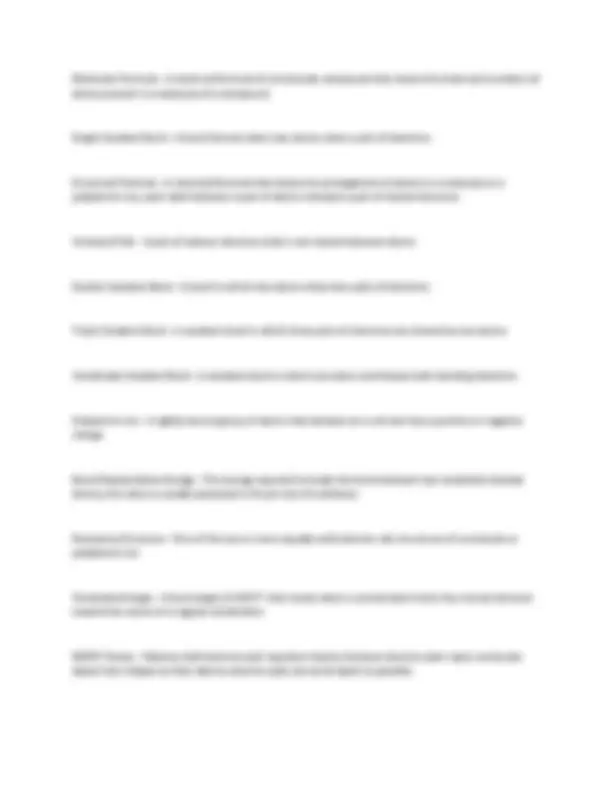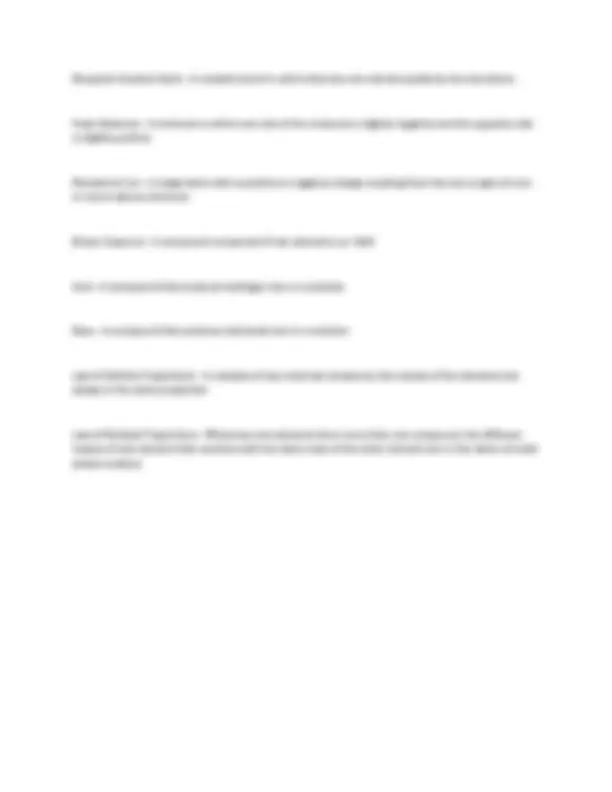




Study with the several resources on Docsity

Earn points by helping other students or get them with a premium plan


Prepare for your exams
Study with the several resources on Docsity

Earn points to download
Earn points by helping other students or get them with a premium plan
Community
Ask the community for help and clear up your study doubts
Discover the best universities in your country according to Docsity users
Free resources
Download our free guides on studying techniques, anxiety management strategies, and thesis advice from Docsity tutors
Honors Chemistry Unit 4 Test | Comprehensive Questions and Answers Latest Updated 2024/2025 With 100% Verified Solutions
Typology: Exams
1 / 4

This page cannot be seen from the preview
Don't miss anything!



Ionic Bond - Force of attraction between two oppositely charged ions formed by one particle losing electrons and another gaining electrons; formed when one atom takes an electron from another atom-- ions are the result (one positive, one negative)--they stick together because of opposite charges; difference between electronegativities is high; formula unit; metals--low electronegativity--lose electrons to form cations; nonmetals--high electronegativity--gain electrons to form anions; metals- nonmetals Covalent Bond - Electrons are shared between atoms with relatively high electronegativity (nonmetals); formed when both atoms have a strong attraction to the electron, so they share the electron--neither atom has a charge; molecules; difference between electronegativities is low; unequal sharing-polar covalent bond; equal non polar covalent bond; nonmetals-nonmetals Metallic Bond - Metal bonded with a metal; two or more metals atoms bonded together; occurs when neither atom has a strong attraction to the electrons; metals have low electronegativity values; metals bonded with other metals have "spare" electrons that end up forming the "sea of electrons" Polar Covalent Bond - Bonds where the electrons are not equally shared--there is a preference for one nucleus over the other Semimetal - Metallic bonds where the electrons are more tightly held; these substances will exhibit fewer metallic properties and more covalent properties Diatomic Molecules - Br2, I2, N2, Cl2, H2,O2, F2; a molecule consisting of two atoms Naming Covalent Compounds Prefixes - 1 - mono 2 - di 3 - tri 4 - tetra 5 - penta 6 - hexa 7 - hepta
8 - octa 9 - nona 10 - deca The Octet Rule - Most elements combine in such a way that each atom tends to have 8 valence electrons, giving it the electron configuration of a noble gas; exception: some elements require less than 8 --ex. Boron (BF3) and Beryllium (BeCl2); exception: some elements their octet allowing more than 8 electrons--use their empty and available d-orbitals, must be in at least the 3rd period--ex. Sulfur (SF6) and Phosphorus (PCl5) Valence Electron - An electron in the highest occupied energy level of an atom Electron Dot Structure - A notation that depicts valence electrons as dots around the atomic symbol of an element; the symbol represents the inner electrons and atomic nucleus; also called Lewis dot structure Halide Ion - A negative ion formed when a halogen atom to gain an electron Ionic Compound - A compound composed of positive and negative ions Chemical Formula - An expression that indicates the number and type of atoms present in the smallest representative unit of a substance Formula Unit - The lowest whole-number ratio of ions in an ionic compound Coordination Number - The number of ions of opposite charge that surround each ion in a crystal Molecule - A neutral group of atoms joined together by a covalent bond Molecular Compound - A compound that is composed of molecules
Nonpolar Covalent Bond - A covalent bond in which electrons are shared equally by the two atoms Polar Molecule - A molecule in which one side of the molecule is slightly negative and the opposite side is slightly positive Monatomic Ion - A single atom with a positive or negative charge resulting from the loss or gain of one or more valence electrons Binary Copound - A compound composed of two elements; ex. NaCl Acid - A compound that produces hydrogen ions in a solution Base - A compound that produces hydroxide ions in a solution Law of Definite Proportions - In samples of any chemical compound, the masses of the elements are always in the same proportion Law of Multiple Proportions - Whenever tow elements form more than one compound, the different masses of one element that combine with the same mass of the other element are in the ration of small whole numbers